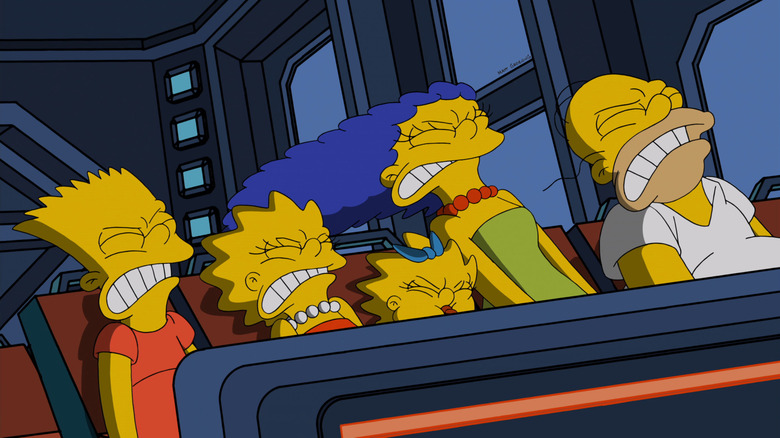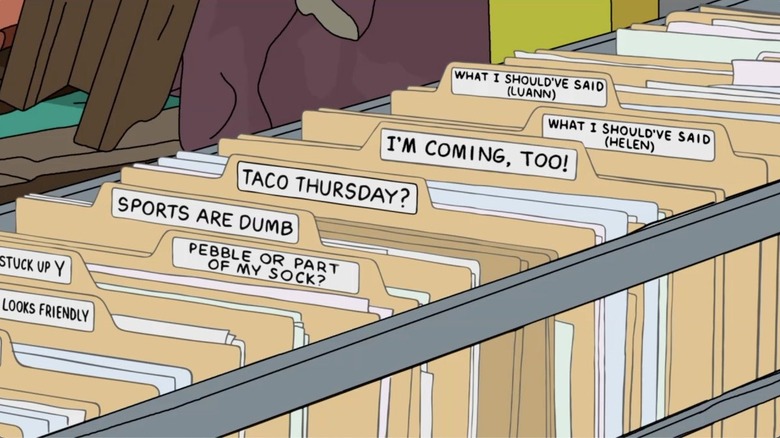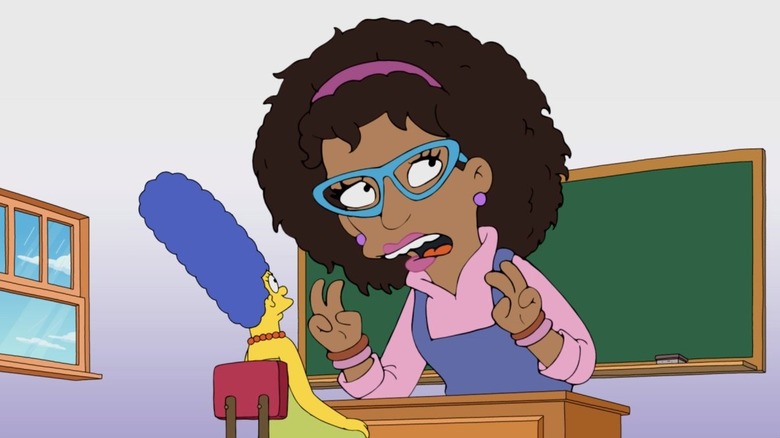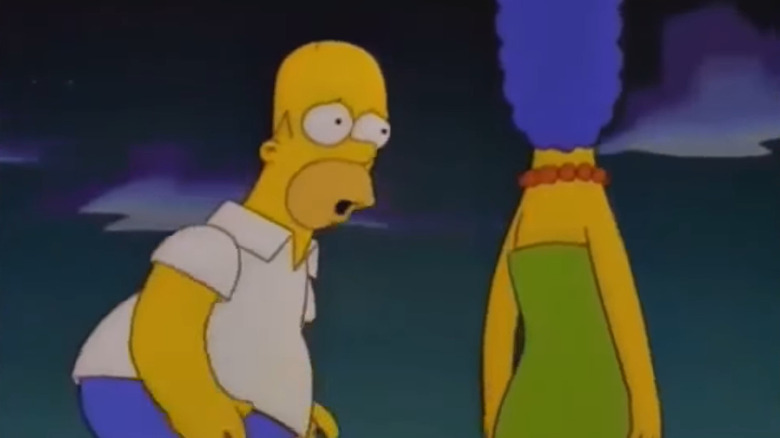The Simpsons Season 35 Pays Tribute To One Of TV's Greatest Dream Sequences
This article contains spoilers for "The Simpsons" season 35, episode 2 — "A Mid-Childhood Night's Dream"
Back in 2000, "The Sopranos" released a groundbreaking season 2 finale in which Tony spends half the runtime experiencing some food poisoning-induced fever dreams. Although the show was already no stranger to dream sequences by this point, "Funhouse" was the most the show had indulged in so far, fully embracing the weird and fragmented experience we all feel while we're asleep. Tony's mind takes him from place to place, from one strange, stilted conversation with someone he knows to another, all of which feels designed to confront him with the uncomfortable fact that one of the guys in his crew is a rat. Deep down, Tony's known this all season, but it's only through these dream sequences that his mind finally forces him to confront it head-on.
24 years later, "The Simpsons" has released its own episode where a food-poisoned Marge experiences a series of stressful dreams, all designed to force her to confront a painful truth. "A Mid-Childhood Night's Dream" starts off with Marge having nostalgic dreams with her young children, but they turn into nightmares as the kids are taken away from her. Sometimes they're taken via giant bubble, reminiscent of one of the show's previous dream episodes "Eternal Moonshine of the Simpson Mind," and sometimes they simply transform into older versions of themselves. Either way, it's not a fun time for Marge; much like Tony 24 years earlier, she's learning the hard way that you can't run from your subconscious forever.
Marge's relatable subconscious
Lest anyone think these parallels are a coincidence, the episode's writer Carolyn Omine confirmed the connection on Twitter last night as the new episode aired: "This episode has homages to many famous dream sequences but the story is an homage to the brilliant 'Funhouse' episode of 'The Sopranos' where Tony gets food poisoning, and in fevered dreams, pieces together the clues as to who is betraying him." Of course, nobody really betrays Marge in this latest episode, except perhaps for the ravages of time.
Omine also acknowledges the episode's homage to "Inception," with Marge's house bursting apart just like how the dream worlds would collapse in the 2010 film, but it's clear that "The Sopranos" is the main influence here. Because as fun as "Inception" was with its dream-within-a-dream premise, "The Sopranos" was more effective at capturing genuine dream logic, as surreal and nonsensical and as it could be. "Inception" never did anything quite as hard-hitting and well-observed as Tony's season 5 dream, where his gun malfunctions just as he's about to shoot his old judgmental football coach. Tony tries to pick the bullets up but they melt in his hands, as the coach yells at him about how he's "Not prepared!" It doesn't just establish Tony's fears about killing off Tony B; it's also precisely the sort of dream most people have had a variation of at some point in their lives.
A visually impressive installment
Maybe the most important thing "The Sopranos" did during its dream sequences was centering the chaos on specific, vivid images; it implies a strong larger memory around what we're seeing, but it also creates the sensation of being trapped in an unsettling, constantly-shifting environment. Such is the case throughout a lot of this Simpsons episode, like when Marge finds herself in a clothing store and knows Bart's gone hiding under one of the clothes racks, but she can't find him. Or when Marge is shrunken down and walking around a version of her home where all her kids' stuff has been packed up and taken away.
But maybe the most effective visual choice was the way it presented Marge's meeting with Bart's teacher, Ms. Peyton. Here, the typically crowded classroom is stripped down to just a desk, a chair, a blank chalkboard, a blindless window, and a blank wall. Even Homer, originally there with Marge at the start, disappears as the scene ramps up its intensity, leaving Marge to deal with it all alone. Then of course there's the teacher herself, who towers over Marge as she talks more and more about how Bart will be heading to fifth grade soon, which is just one year away from middle school, which is right before high school and then college and then Bart will be all grown up and gone forever.
It's genuinely smart, creative directing, made more impressive by how stiff the show's animation has often looked in its later seasons. After "The Simpsons" switched to HD it often felt like the show was phoning it in on the animation front, but it's impossible to accuse this episode of the same crime.
Following The Simpsons tradition
Of course, no discussion of dream sequences in "The Simpsons" can be complete without mentioning "The Mysterious Voyage of Our Homer." The season 8 episode follows Homer's own panicky fever dream after he eats a dangerous amount of extra spicy chilly. The episode's filled with its own surreal imagery and unsettling dreamlike elements, including that haunting sequence where Homer's trying to see Marge's face, but no matter how much he runs around her he's only ever seeing the back of her head. Not only does it perfectly capture a common dream experience, but it captures Homer's fears of losing Marge forever, and his frustration of never quite being able to say the right thing. This episode came out in 1997, two years before "The Sopranos" premiered, but it was already handling its characters' dream sequences with just as much creative brilliance. (It also begs the question: Did "The Sopranos" borrow from "The Simpsons" first?)
Which Simpsons episode did it better? It's hard to say. The season 8 episode had that sharper Classic Simpsons wit to it, and it managed to build a stronger sense of otherworldly unease even outside of Homer's dreams. It's genuinely pretty creepy when we hear the dog in the real world talk to Homer in the dream coyote's voice, leaving us unsure exactly how much of Homer's dream/hallucination was just in his mind. But although "A Mid-Childhood Night's Dream" might draw too fine a line between the dream world and the waking one, it makes up for it with a more focused, conclusive story about Marge's fears of her kids growing up too fast. It makes for one of the best episodes of the recent seasons, and it's got "The Sopranos" (and itself) to thank.



